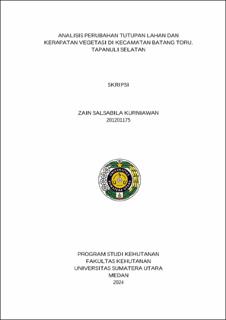| dc.description.abstract | The Batang Toru landscape is an ecosystem that is very important for the protection and preservation of life support systems and germplasm preservation, both at the local, national and global levels. Forest destruction is the main factor in changes to landscape structure. Land cover in an area always changes over time. Batang Toru is also the main place for saving the ecosystem which is the habitat of the Tapanuli Orang Utan (Pongo Tapanuliensis) as the most endangered animal currently and various types of rare plant species and other wild animals. The increase in population also greatly influences the increase in land use by humans. The data processing method in this research aims to identify and analyze the condition of each land cover for the period 2004, 2017 and 2024 in the landscape of Batang Toru District, South Tapanuli and also to analyze the suitability of the condition of land vegetation density in Batang Toru District in 2004, 2017 and 2024 obtained through land cover processing with guided classification methods and NDVI analysis, data processing techniques in this research use software analysis tools ArcGis 10.8 and Microsoft Excel. The research results show that throughout 2004-2024 Batang Toru District had seven main land cover classes, namely, primary forest, secondary forest, rice fields, plantations, water bodies, open land and settlements, and one type of land cover class was added in 2017, namely mining. The dominant land cover types other than forests are plantations, rice fields and settlements with an area of 6,556.35 Ha, 1,020.29 Ha and 1,001.25 Ha. The level of vegetation density in Batang Toru District is divided into 5 classes, namely non-vegetation, very low, low, medium, and high | en_US |


